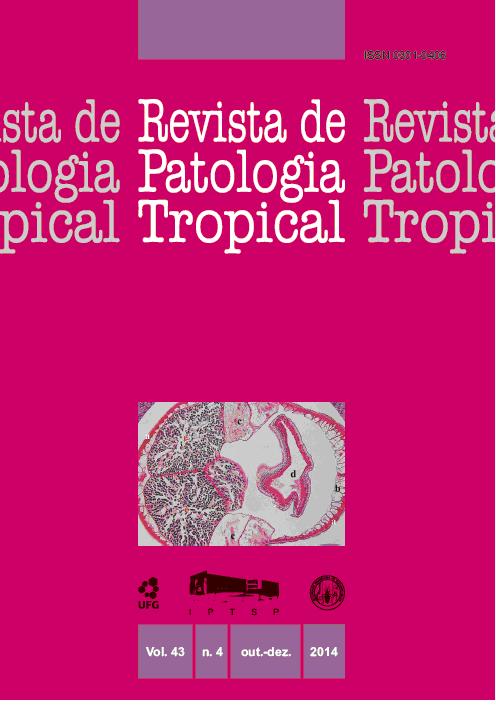SPATIAL DISTRIBUTION AND TEMPORAL VARIABILITY OF PHLEBOTOMINAE AT THE CUIABÁ CAMPUS OF THE FEDERAL UNIVERSITY OF MATO GROSSO, BRAZIL
DOI:
https://doi.org/10.5216/rpt.v43i4.33615Keywords:
Leishmaniasis, vector, population dynamics, abiotic factorsAbstract
Phlebotomine sand flies are vectors of Leishmania to humans and other animals. The aim of thisstudy was to verify the spatial distribution and effect of some abiotic factors on the abundance andtemporal variability of Phlebotominae at the Cuiabá campus of the Federal University of MatoGrosso (600,000 m2). CDC traps were installed at distances of 1,000 to 300 m s from each other andat a height of 1.5 m from the ground, between 17:00 and 07:00, distributed at six sites on the campus.Monthly collections were made on three consecutive days from December 2008 to December 2011.The living sand flies captured were sacrificed in ethyl acetate and then screened under a stereoscopicmicroscope. The insects were then subjected to clarification and identified. The abiotic data oftemperature and average relative humidity during the times when the traps remained at the insectcollection sites were determined with a digital thermometer-hygrometer. A non-linear mathematicalmodel was used to evaluate the association between the abiotic variables and the number of insectscaught. Species of Phlebotominae with and without the capacity to transmit Leishmania werecaptured at the site during the study period. The abundance of phlebotominae presented spatial andtemporal variability by virtue of abiotic and other variables. The most favourable conditions forthe occurrence of Phlebotominae at the site were a temperature of 23.2 ºC and a relative humidityof 70%. Temperatures above 35 °C or below 18 °C and a relative humidity lower than 18% wereunfavourable for the Phlebotominae.Downloads
Downloads
Published
How to Cite
Issue
Section
License
The manuscript submission must be accompanied by a letter signed by all authors stating the full name and email address, confirming that the material has not been published or is under consideration for publication elsewhere, and agreeing to transfer copyright in all media and formats for Journal of Tropical Pathology. The authors will not be paid for published articles. They are solely responsible for the content of those articles, even if the Editor holds the right to adjust them to the norms of the journal.
The reviewers will not be paid for the peer review process.

